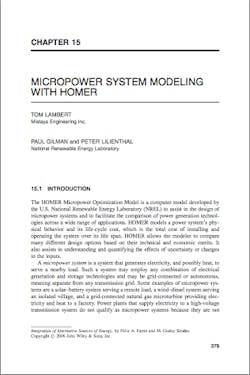The HOMER Micropower Optimization Model is a computer model developed by the U.S. National Renewable Energy Laboratory (NREL) to assist in the design of micropower systems and to facilitate the comparison of power generation technologies across a wide range of applications. HOMER models a power system’s physical behavior and its life-cycle cost, which is the total cost of installing and operating the system over its life span. HOMER allows the modeler to compare many different design options based on their technical and economic merits. It also assists in understanding and quantifying the effects of uncertainty or changes in the inputs.
A micropower system is a system that generates electricity, and possibly heat, to serve a nearby load. Such a system may employ any combination of electrical generation and storage technologies and may be grid-connected or autonomous, meaning separate from any transmission grid. Some examples of micropower systems are a solar–battery system serving a remote load, a wind–diesel system serving an isolated village, and a grid-connected natural gas microturbine providing electricity and heat to a factory. Power plants that supply electricity to a high-voltage transmission system do not qualify as micropower systems because they are not dedicated to a particular load. HOMER can model grid-connected and off-grid micropower systems serving electric and thermal loads, and comprising any combination of photovoltaic (PV) modules, wind turbines, small hydro, biomass power, reciprocating engine generators, microturbines, fuel cells, batteries, and hydrogen storage.
